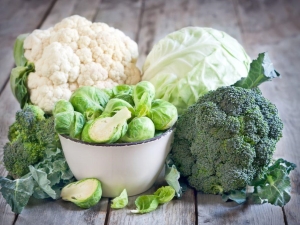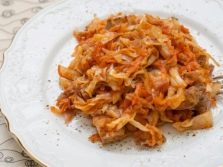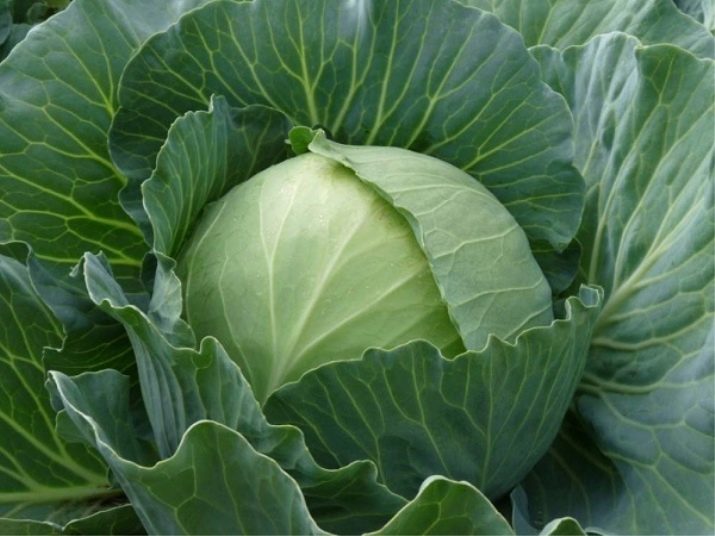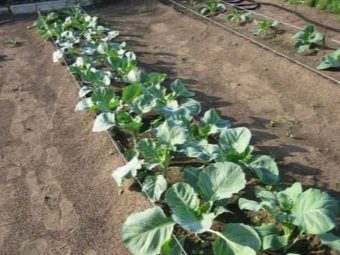Choosing varieties of early cabbage

Long since cabbage has been a common dish. It can be used in any form: raw, fried, stewed, pickled.It can be both a separate dish (cabbage rolls, stews), and a good side dish to meat or fish. It is the desire to increase the yield of cabbage encourages breeders to bring new varieties of this vegetable.
Early cabbage allows you to harvest in the second half of June. Any variety of early cabbage has a number of qualities that attract both professional gardeners and amateur summer residents. This is a quick and early maturation of the culture, good tolerance of sufficiently low temperatures.
Characteristics
Early cabbage belongs to those garden crops that are fairly easy to grow. Proper observance of the rules of planting plants and simple care for them will help to collect a large crop of beloved by all vegetables.
The right choice of variety will be the key to a rich harvest. Choosing the right variety of early ripe cabbage is based on several criteria:
- The duration of the summer period in a particular area. Under this item is meant exactly the number of sunny days. In different regions, the number of warm days can vary from one to three or four months. The amount of crop ripening and the method of sowing will depend on their number.
- For what purpose cabbage will be used (preserved, braised, pickled).
- Important is storage time.
The period for which ripening early cabbage, on average takes from 65 to 100 days. Forks ripen in early summer (often this is the beginning of June). Fresh cabbage is used to prepare various dishes in natural form (soups, snacks, blanks, vegetable stews, pies, multiple side dishes). Vegetable is well suited for salting and marinade, because its shelf life is lower than that of ordinary cabbage.
With long storage the fruit becomes softer, it looks bad and quickly flakes. It is important to prevent overriding of the vegetable, as it starts to crack.
Early ripe culture does not bring a good harvest, and her taste palette is not as rich as that of a later one.
The head of cabbage is loose in its structure, but strong inside. Early ripe cabbage is good for fresh consumption. It is used in the preparation of cabbage juice and various salads with fresh cabbage.
Varieties
The main advantage of early cabbage is a small ripening period. In just a hundred days she will bring a full harvest. The first half of June is the time when many varieties of cabbage ripen.
It is best to eat fresh cabbage after it is harvested from the garden. During this period, it is characterized by juiciness, tenderness and an abundance of vitamins. You can harvest such cabbage by marinating or pickling.
The abundance of cabbage varieties will delight any gardener.
Consider the descriptions of the best varieties of white cabbage:
- Rinda variety is an early ripe hybrid. He is thermophilic, so he feels comfortable in the regions where summer is warm and long enough. The size of the head is average. The leaves of the plant are large and spreading, pale green. Gardeners "Rinda" is valued for its excellent taste, unpretentious care and resistance to temperature fluctuations. The shelf life of heads can reach 3.5 - 4 months. For such a long storage you need to organize the necessary conditions.
Acceptable temperature - not below +8 degrees Celsius. It is also necessary to constantly maintain humidity at a moderate level.
- Ultra early varieties of cabbage will delight lovers of vegetables with a crop just a month after planting. Variety "Kazachok" refers to ultra early. It bears fruit forty days after planting in open ground. The variety is very tasty and delicate, but at the same time crispy. From the inside, a strong head of cabbage has a milky hue; friability is minimized. The head of such a lettuce-colored cabbage, weight - 1.5 kg (subject to proper care). "Cossack" rarely overrides, does not crack.
Agronomists advise planting seedlings directly on open beds, but for additional protection of seedlings, you can use a temporary film cover. The plant is resistant to small frosts and diseases, it is also not afraid of pests.
- The June variety has become widespread in the Russian latitudes. It is intended for regions where a temperate climate prevails. Cabbage has a mild flavor, dense in structure. The weight of the head is two to three kilograms. Maturation of culture, as the name implies, occurs towards the end of June. This cabbage is perfect for use in salads, a variety of cold appetizers. Its distinctive feature is the perfect combination with other vegetables, especially tasty stew. "June" cabbage is unpretentious, requires minimal care. She is well acclimatized in the open field, but can be grown in a film greenhouse.
- "Dita" - an early variety that ripens by the hundredth day after planting in the garden. Heads are spherical, with a long leg. The head is small, weight - up to one kilogram. Cabbage is good for storage (up to three or four months), it tolerates transportation. Cracking it is not scary.
- Young variety "Express" - super early cabbage. Vegetable ripening time is about forty days. The variety is characterized by high yield. The standard size of the head rarely exceeds one and a half kilograms. Heads with proper storage lasts up to four months.
- Sort "Surprise" - Dutch medium early cabbage. Like many brothers, she matures in a hundred days. The vegetable has green heads of the correct spherical shape, which are not subject to cracking.
- If we consider the varieties created for a cold climate, we should mention the "Arctic". This is an indispensable variety in the cold northern latitudes. It is unpretentious and at the same time ripens fairly quickly (after a month and a half, you can shoot the first harvest). But it is worth considering that such a hybrid needs good light and sufficient moisture.
- Variety "Parel" also has an early ripening period - up to two months. Heads for weight are 1300-1400 grams, strong. They tolerate transportation, well-kept. The taste of cabbage is juicy, crispy. The plant is grown both in the garden and in the greenhouse.
- "Nozomi" - a very early variety, its ripening period is a record forty days. Forks "Nozomi" spherical, have smooth, smooth edges. The mass of one ranges from one and a half to two kilograms. The heads are dense, so you can not be afraid that they will crack during ripening. Vegetables are well tolerated in transportation, suitable for further storage (without losing their taste). The seedling is distinguished by enviable resistance - it can tolerate slack frosts, it is not afraid of excessive moisture. She is not afraid of fungus, including the "black leg".
- "Transfer F1" - mid-early variety, which matures in about 100 days. It is resistant to temperature fluctuations, endures little frost. Heads of light green shade, weight reaches one and a half kilogram. The fruits of this variety are excellent salad cabbage.
- If high yield of a vegetable is important for garden owners, they will like the variety Torbiya. The variety is an early ripe hybrid. The weight of the head reaches 3 - 3.5 kg. Cabbage does not overheat, is not prone to cracking, has a wonderful juicy taste. Heads of rounded, smooth, have a smooth shiny surface. The head is dense, from the inside it has a light yellow tint. Shelf life should not exceed two months.
Consider a variety with the exotic name "Akira". To the positive sides of the variety include:
- transportability;
- weight within one and a half to two kilograms;
- strong head;
- resistance to decay.
Breeders have deduced many varieties of white-vegetable: "Ditmarshur Fruere", "Point", "Start", "Kevin", "Sprint", "Golden", "Hectar".Such a variety not only pleases buyers, but also allows you to choose the cabbage most experienced gardener.
You should not bypass the early ripe cauliflower. Compared to white cauliflower, it requires more care for itself. Instability to diseases, pests and temperature differences are compensated by excellent taste. Taste is not lost even during the heat treatment of vegetables (frying, stewing).
In cauliflower there are many useful vitamins of groups A and E. The presence of antioxidants, which are responsible for the removal of toxins from the human body, makes cauliflower not only tasty, but also a useful vegetable. It is recommended to be eaten both by adults and children.
Cauliflower variety "Snowball" got its name because of its similarity with a lump of snow. The heads of vegetables are solid in structure. Their weight is 650 - 800 grams (with proper care can reach one kilogram). Cauliflower can be consumed immediately after harvest. At the same time cabbage is perfect for stewing with other vegetables.
Sort "Express" refers to the new varieties. It has small leaves and small heads. The mass of one head can exceed 400 grams. They have a white and yellow color and spherical shape.
Cabbage needs to be planted in early May, it begins to bear fruit after two months. It is best to plant cabbage in a greenhouse or under a film cover. This will provide additional protection for weak and unstable seedlings. "Express" is well tolerated by the disease, but unstable to pests.
If we consider the early varieties of broccoli, then among them should be mentioned the varieties "Batavia", "Linda", "Lord", "Monaco" and "Tonus".
How to choose?
The choice of early ripe cabbage should be treated with responsibility. Often it is the right choice of the variety that guarantees half the success in harvesting the vegetable.
It is important to take into account the climate of the region where the plant will be located. The climate of the Moscow region, the Urals and Siberia is very different. What can be planted in central Russia is not suitable for the northern regions. But this does not mean that residents of cold areas should abandon the cultivation of early cabbage. It can be planted, for example, in a greenhouse.
It is best to purchase seeds in specialized gardening stores. It is there that presents the largest assortment of seeds. Buying seeds from “acquaintances" often ends up with a bad harvest - then the vegetables will not ripen, or a completely different plant will grow.
According to experienced gardeners, be sure to pay attention to the packages with seeds. The reverse side of the package contains detailed information about the vegetable, producer, shelf life and ripening. Sometimes this information is enough for the proper selection of vegetables.
Shelf life of seeds is important. If it is absent, it is better to refrain from buying. Buying expired seeds is fraught with the complete absence of seedlings and, as a result, the harvest itself. You can buy several types of seeds from different manufacturers. This will reduce the risk of a bad harvest.
Growing tips
Growing early cabbage is not difficult. If you follow certain tips, you can get a rich harvest:
- Cabbage needs water. To conduct watering is regularly and carefully. It is important not to pour young shoots.
- Soil loosening helps the plant to climb and promotes the penetration of oxygen into the deeper layers of the soil In dry weather, it is loosening and frequent watering that help the cabbage survive.
- Watering culture can be made with cold water. This seemingly unimportant fact turns out to be very significant in practice. Gardeners do not have to spend time on heating water in barrels, you can water the vegetable directly from a hose.
- It is possible to plant cabbage into the ground or greenhouse when there are about five to six leaves on the shoot. After planting seedlings in open ground, it is recommended to cover the film from exposure to bright sunlight.
- Cabbage does not tolerate severe frosts. This is especially true in May and the first half of June. To protect the young shoots, cabbage is best covered with a special covering material or plastic wrap. This will be additional protection for wind and excessive moisture.
- The area on which the cabbage should be planted should take at least half a square meter per seedling. Thickly planted plants are poorly ventilated, do not receive enough light. In this regard, the seedlings simply start to hurt and rot.
Favorable "predecessors" of the vegetable include:
- legumes (peas, beans, beans);
- onion and garlic;
- pumpkin;
- squash, squash;
- cereals (wheat, rye or oats).
Hilling of vegetables should be carried out not earlier than three weeks after planting. During this time, the seedlings have time to grow and get stronger, so the mechanical effect in the form of hilling will not hurt them. The optimum temperature for early ripe cabbage ranges from 17 to 21 degrees Celsius.
Weeding must be thorough and regular. This will help the plant to gain more nutrients and beneficial trace elements.
Early varieties are more often prone to disease and the effects of pests, so proper care is so important. Feed the cabbage should be carried out after the plant has taken root and gain strength in the garden. Wood ash treatment will help prevent cabbage diseases, save from some types of pests.
In the future, fertilizing can be done two or three times a month, every 10 to 15 days. When feeding, you should alternately combine an organic solution (mullein solution, brewer's yeast), fertilizers (urea, ammonium nitrate, nitrophoska).
Mineral fertilizers saturate a vegetable with useful substances that are necessary for its growth and development. Top-dressing with mineral fertilizers is done through watering cabbage.
Watering should be done twice a day, namely in the morning or in the evening. At this time, the sun is the least active, so the plant is less likely to get burned by the sun.
When working with mineral fertilizers, a gardener must be careful and observe at least minimal safety precautions.
Direct contact of the mineral fertilizer with skin, eyes, and mucous membranes should be avoided. Therefore, it is important to work in rubber gloves. Proper dosage of top dressing with minerals will help the plant to avoid getting a chemical burn.
Organic fertilizer will help the plant to accumulate useful substances. Organic fertilizers need to be made two weeks after feeding mineral substances.
Comprehensive care will provide cabbage with all the necessary vitamins and elements, which in turn will help summer residents to get a high yield of their favorite vegetable.
To learn how to grow early cabbage, see the following video.


























































